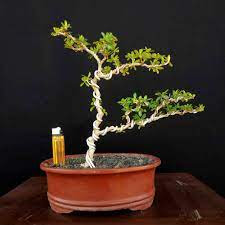Everything You Must Know About How Do Olives Grow (2022)
 black olive tree bonsai - Cut out a minimum of 2 inches in diameter around the swelling in summer to prevent the disease from rock juniper bonsai spreading. Years with over rainfall can cause peacock spot fungal disease to the olive trees. This infection can cause premature fruit drop and patches on the leaf blades. To prevent the disease apply copper fungicide in late fall. An oval shell insect named Scale sucks the vital fluid from the stems and leaves of the tree. To get rid of this insect use horticultural oil or just crush it. A fungal disease is known as verticillium results in discoloration and curls to the leaves.
black olive tree bonsai - Cut out a minimum of 2 inches in diameter around the swelling in summer to prevent the disease from rock juniper bonsai spreading. Years with over rainfall can cause peacock spot fungal disease to the olive trees. This infection can cause premature fruit drop and patches on the leaf blades. To prevent the disease apply copper fungicide in late fall. An oval shell insect named Scale sucks the vital fluid from the stems and leaves of the tree. To get rid of this insect use horticultural oil or just crush it. A fungal disease is known as verticillium results in discoloration and curls to the leaves.
How Many Years Can An Olive Tree Live?
Olive trees have a long history of cultivation-from ancient Greece, where olive groves were tended with care, to the modern orchards that supply your kitchens with olive oil and tapenades. If you're looking for the freshest olive tapenade, you might be considering growing an olive tree yourself. In that case, you'll want to know all the tips and tricks for keeping your olive tree alive and thriving. Here's everything you need to know about taking your olive tree from seedling to success. What type of olive tree should you grow? What type of olive tree should you grow? There are many types of olive trees, and each one has its merits.
Can The Dwarf Black Olive Be Inside?
But now that you do know, it may be difficult to ignore your need for one little indoor olive tree. Want to make a new friend? Because an olive tree is often seen as a sign of friendship, and the offering thereof. Haven't you ever heard the term, offering an olive branch? That's because it is used as a peace offering. The need to end an argument and become friends once again. It means you're trying to find peace for the betterment of everyone. How Much Sun Does An Indoor Olive Tree Need? Though it can vary, generally olive trees require a minimum of 6 hours of sunlight each day. So it's important to ensure that these trees are placed near a window that gets that much sunshine.
Do Olive Trees Last Forever?
Olive trees can be grown all over the world in areas where winter temperatures do not fall below freezing. In the United States, they can be grown in USDA growing zones 8-10. Olives can be used for many things, from delicious garnishes to an excellent, cold-pressed cooking oil. In the wild, the trees grow from seeds that are spread by birds and animals. Modern growers often grow olive trees from cuttings because cuttings are essentially the material to clone identical trees from the original. This is especially useful when propagating hybridized olive trees. Growing olive trees from cuttings is done in much the same way as growing any other tree from a cutting.
Black Olive Bonsai
What to feed olive trees in pots? Although they can cope with dry periods, olives in containers need regular watering and feeding to produce fruit. During the growing season, keep the compost moist and feed with a balanced liquid fertiliser such as Phostrogen, every month. Do you need to water olive trees? One must give the olive tree water regularly this is a must. Olive trees that are planted in pots or just planted in the ground, black olive tree have a compact root ball. It is necessary to ensure that the soil does not completely dry out. Occasional watering is required and needed also in the winter time.
How Big Is A 3 Year Old Olive Tree?
A young olive tree can grow closer to the top of this range during its first few years, but as it grows, growth slows and the tree becomes more slender. Are olive trees hard to grow? Olive trees are slow-growing plants that normally increase just 2 to 4 inches in height per year, depending on the variety. Indoor olive trees grow even more slowly than those that are planted in the ground, and they normally only require repotting in a larger container every few years or less. Is olive tree toxic to dogs? There is no evidence to imply that any portion of the olive tree (Olea europaea) is toxic to animals, and this is supported by scientific research.
The species is very variable and no two trees ever seem to be quite the same. As far as bonsai is concerned we are going to encounter three main groups where the foliage is the defining characteristic. O. europaea; formerly classified as the subspecies O. europaea oleaster. By far the best type for bonsai cultivation. Tiny leaves, vertical growing twigs when mature. Good examples will have spectacular bark and natural deadwood. Generally collected from the wild in costal regions. Unusually for a dwarf foliage type oleaster is extremely vigorous and forgiving. Most expensive but this is the one to buy! Mediterranean region. Medium size dark green shiny leaves generally more rounded than oleaster.
No comments :
Post a Comment